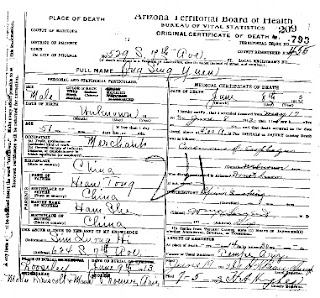 |
| Arizona Vital Records - Genealogy - Death Certificate |
They worked in small, family-run businesses such as restaurants, grocery stores, hand laundries and vegetable farms. Although many of Phoenix's early Chinese residents eventually returned to China, about fifty were buried in the Pioneer & Military Memorial Park.
In 1993, archaeologist K. J. Schroeder asked William Tang, an associate professor at Arizona State University, to translate the inscription on the marble headstone in Loosley. Tang, a Mandarin speaker from northern China, translated it as that of Tang Xian Yuan, born in Canton province, Hoiping district, Da Lou village.
Years later, PCA researchers discovered the death certificate of Ong Sing Yuen, aged about 51, who died 8 June 1913 and was buried in Loosley. Since the man buried in Loosley had been born in province, he would almost certainly have been a speaker of Cantonese, and 'Ong Sing Yuen' is in fact the Cantonese equivalent of the Mandarin 'Tang Xian Yuan'. - Adapted from a story by Donna Carr
Ong was a merchant living at 529 S. 7th Avenue, and there are many more things to know about him.
If you would like to learn more about Ong, visit the Chinese Pioneer Memorial and us at our Pioneer Military and Memorial Park library!
















